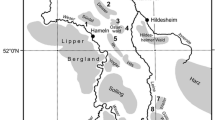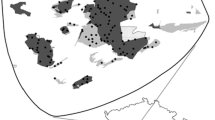Abstract
The extent to which the diversity of forest-inhabiting bryophytes is related to forest management practices has been the subject of a recent study. However, the question of how these practices affect the spatial distribution pattern of bryophyte diversity throughout managed European forests remains unanswered. We surveyed bryophyte diversity in six large forest complexes in the Czech Republic. Our sites encompass a range of managed forest stands (including various temporal phases such as clearings and young forests) across a gradient of environmental conditions. In general, the bryophyte species richness in managed forests was less than in unmanaged forests. Only unmanaged forest stands that provided suitable substrates such as large dead woody debris and large diameter beeches (Fagus sylvatica) were able to support rare bryophyte species. Mature managed forests with simplified tree structure, dominated by either deciduous or coniferous species shared similar bryophyte species richness (α-diversity) and pool (γ-diversity). It appears that forest management, which leads to the loss of old-growth forest attributes, may result in low-diversity bryophyte communities regardless of tree species composition. Nevertheless, bryophyte species turnover (β-diversity) was spatially uniform in mature managed forests dominated by conifers, but quite variable in those dominated by deciduous tree species. Managed forests with diverse tree structure and composition approximated the species pool size of unmanaged forests, in spite of their small contribution to the total area of managed forests. Hence, forest management as commonly applied in the managed forests of the Czech Republic does not appear to be conducive to the persistence of diverse bryophyte assemblages. We suggest that some essential changes in forest management practices are necessary to maintain the conditions favorable to the preservation of bryophyte diversity in central European forests.






Similar content being viewed by others

References
Aude E, Poulsen RS (2000) Influence of management on the species composition of epiphytic cryptogams in Danish Fagus forests. Appl Veg Sci 3:81–88
Bauhus J, Puettmann K, Messier C (2009) Silviculture for old-growth attributes. For Ecol Manag 258:525–537
Bengtsson J, Nilsson SG, Franc A, Menozzi P (2000) Biodiversity, disturbances, ecosystem function and management of European forests. For Ecol Manag 132:39–50
Brunet J, Fritz Ö, Richnau G (2010) Biodiversity in European beech forests—a review with recommendations for sustainable forest management. Ecol Bull 53:77–94
Chytrý M (2012) Vegetation of the Czech Republic: diversity, ecology, history and dynamics. Preslia 84:427–504
de Mendiburu F (2014) Statistical procedures for agricultural research. R—package, version 1:1–7
Felton A, Lindbladh M, Brunet J, Fritz Ö (2010) Replacing coniferous monocultures with mixed-species production stands: an assessment of the potential benefits for forest biodiversity in northern Europe. For Ecol Manag 260:933–947
Fenton NJ, Frego KA (2005) Bryophyte (moss and liverwort) conservation under remnant canopy in managed forests. Biol Conserv 122:417–430
Friedel A, von Oheimb G, Dengler J, Härdtle W (2006) Species diversity and species composition of epiphytic bryophytes and lichens—a comparison of managed and unmanaged forests in NE Germany. Feddes Repert 117:172–185
Friedman J, Walheim M (2000) Amount, structure, and dynamics of dead wood on managed forestland in Sweden. For Ecol Manag 131:23–36
Fritz Ö, Gustafsson L, Larsson K (2008) Does forest continuity matter in conservation?—a study of epiphytic lichens and bryophytes in beech forests of southern Sweden. Biol Conserv 141:655–668
Gillson L, Willis KJ (2004) ′As earth′s testimonies tell′: wilderness conservation in a changing world. Ecol Lett 7:990–998
Grove SJ (2002) Saproxylic insect ecology and the sustainable management of forest. Annu Rev Ecol Evol Syst 33:1–33
Hansen AJ, Spies TA, Swanson FJ, Ohmann JL (1991) Conserving biodiversity in managed forests. Bioscience 41:382–392
Heilmann-Clausen J, Aude E, Christensen M (2005) Cryptogam communities on decaying deciduous wood—does tree species diversity matter? Biodivers Conserv 14:2061–2078
Hochberg Y (1988) A sharper Bonferroni procedure for multiple tests of significance. Biometrika 75:800–803
Kaplan JO, Krumhardt KM, Zimmermann N (2009) The prehistoric and preindustrial deforestation of Europe. Quat Sci Rev 28:3016–3034
Kučera J, Váňa J, Hradílek Z (2012) Bryophyte flora of the Czech Republic: updated checklist and Red List and a brief analysis. Preslia 84:813–850
Lindenmayer DB, Laurance WF (2012) A history of hubris—cautionary lessons in ecologically sustainable forest management. Biol Conserv 151:11–16
Lindenmayer DB, Franklin JF, Lõhmus A, Baker SC, Bauhus J, Beese W, Brodie A, Kiehl B, Kouki J, Martínez Pastur G, Messier C, Neyland M, Palik B, Sverdrup-Tygeson A, Volney J, Wayne A, Gustafsson L (2012) A major shift to the retention approach for forestry can help resolve some global forest sustainability issues. Conserv Lett 5:421–431
Löbel S, Rydin H (2010) Trade-offs and habitat constraints in the establishment of epiphytic bryophytes. Funct Ecol 24:887–897
Löbel S, Snäll T, Rydin H (2006) Metapopulation processes in epiphytes inferred from patterns of regional distribution and local abundance in fragmented forest landscapes. J Ecol 94:856–868
Lõhmus A, Lõhmus P, Vellak K (2007) Substratum diversity explains landscape-scale co-variation in the species-richness of bryophytes and lichens. Biol Conserv 135:405–414
Moning C, Müller J (2009) Critical forest age thresholds for the diversity of lichens, molluscs and birds in beech (Fagus sylvatica L.) dominated forests. Ecol Indic 9:922–932
Müller J, Bütler R (2010) A review of habitat thresholds for dead wood: a baseline for management recommendations in European forests. Eur J For Res 129:981–992
Müller J, Brunet J, Brin A, Bouget C, Brustel H, Bussler H, Förster B, Isacsson G, Köhler F, Lachat T, Gossner MM (2012) Implications from large-scale spatial diversity patterns of saproxylic beetles for the conservation of European Beech forests. Insect Conserv Diver 6:162–169
Müller J, Jarzabek-Müller A, Bussler H, Gossner MM (2013) Hollow beech trees as keystone structures for saproxylic beetles by analyses of functional and phylogenetic diversity. Anim Conserv 17:154–162
Nelson CR, Halpern CB (2004) Short-term effects of timber harvest and forest edges on ground-layer mosses and liverworts. Can J Bot 83:610–620
Nordén B, Appelquist T (2001) Conceptual problems of ecological continuity and its bioindicators. Biodivers Conserv 10:779–791
Ódor P, Standovár T (2001) Richness of bryophyte vegetation in near-natural and managed beech stands: the effects of management-induced differences in dead-wood. Ecol Bull 49:219–229
Ódor P, Király I, Tinya F, Bortignon F, Nascimbene J (2013) Patterns and drivers of species composition of epiphytic bryophytes and lichens in managed temperate forests. For Ecol Manag 306:256–265
Oksanen J, Blanchet FG, Kindt R, Legendre P, Minchin PR, O’Hara RB, Simpson GL, Solymos P, Stevens MHH, Wagner H (2012) Vegan: community ecology package. R—package, version 2.0–5
Perhans K, Appelgren L, Jonsson F, Nordin U, Söderström B, Gustafsson L (2009) Retention patches as potential refugia for bryophytes and lichens in managed forest landscapes. Biol Conserv 142:1125–1133
Pickett STA, Thompson JN (1978) Patch dynamics and the design of nature reserves. Biol Conserv 13:27–36
Pokorný P (2005) Role of man in the development of Holocene vegetation in Central Bohemia. Preslia 77:113–128
R Development Core Team (2013) R: a language and environment for statistical computing. R Foundation for Statistical Computing, Vienna, Austria, http://www.r-project.org/. Accessed Feb 2013
Rosenvald R, Lõhmus A (2008) For chat, when, and where is green-tree retention better than clear-cutting? a review of the biodiversity apsects. For Ecol Manag 255:1–15
Rudolphi J, Jönsson MT, Gustafsson L (2013) Biological legacies buffer local species extinction after logging. J Appl Ecol 51:53–62
Snäll T, Ehrlén J, Rydin H (2005) Colonization-extinction dynamics of an epiphyte metapopulation in a dynamic landscape. Ecology 86:106–115
Söderström L (1988) The occurrence of epixylic bryophyte and lichen species in an old natural and a managed forest stand in northeastern Sweden. Biol Conserv 45:169–178
Tolasz R (ed) (2007) Climate atlas of Czechia. Czech Hydrometerorological Institute, Prague
Vandekerkhove K, De Keersmaeker L, Baeté H, Walleyn R (2005) Spontaneous re-establishment of natural structure and related biodiversity in a previously managed beech forest in Belgium after 20 years of non intervention. For Snow Landsc Res 79:145–156
Vandekerkhove K, De Keersmaeker L, Menke N, Meyer P, Verschelde P (2009) When nature takes over from man: dead wood accumulation in previously managed oak and beech woodlands in North-western and Central Europe. For Ecol Manag 258:425–435
Vellak K, Paal J (1999) Diversity of bryophyte vegetation in some forest types in Estonia: a comparison of old unmanaged and managed forests. Biodivers Conserv 8:1595–1620
Acknowledgments
We thank K. Baltaziuk, L. Čížek, V. Iarema, A. Petrbok, and A. Tenčík for field assistance. GIS analyses were provided by T. Svoboda and P. Kukla, and some problematic records helped to determine J. Kučera. We thank J. Titus and Editage for revising the English. The Editor and anonymous referee kindly provided valuable comments and suggestions on the manuscript. We are grateful to the respective forest administrations for cooperation in our research. This study was supported by Grant SP/2d1/146/08 from the Ministry of the Environment of the Czech Republic.
Author information
Authors and Affiliations
Corresponding author
Additional information
Communicated by T.G. Allan Green.
Electronic supplementary material
Below is the link to the electronic supplementary material.
Rights and permissions
About this article
Cite this article
Hofmeister, J., Hošek, J., Holá, E. et al. Decline in bryophyte diversity in predominant types of central European managed forests. Biodivers Conserv 24, 1391–1402 (2015). https://doi.org/10.1007/s10531-015-0863-2
Received:
Revised:
Accepted:
Published:
Issue Date:
DOI: https://doi.org/10.1007/s10531-015-0863-2



